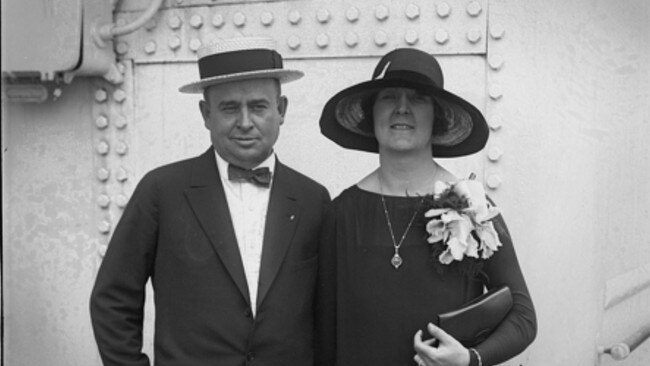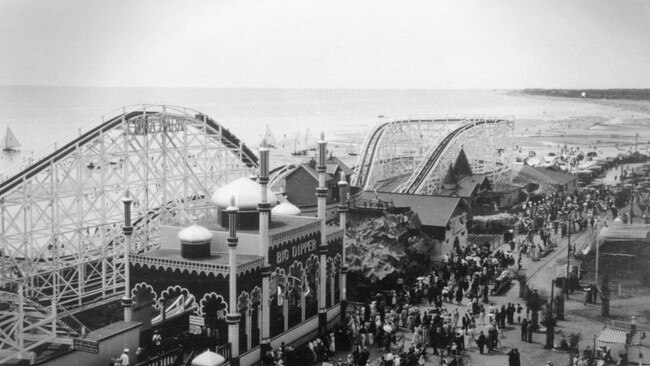How a US entertainment titan dreamed up St Kilda’s Luna Park
He was a Hollywood visionary who signed Charlie Chaplin, but James Dixon Williams also left an indelible mark on Melbourne.

News
Don't miss out on the headlines from News. Followed categories will be added to My News.
On a warm Saturday in December 1913, it seemed like half of Melbourne had packed the St Kilda foreshore for the entertainment event of the year.
The freshly constructed Luna Park was throwing open its doors for the first time and more than 22,000 eager patrons filed beneath the teeth of the now iconic ‘big mouth’.
As adults and children alike marvelled at the towering scenic railway, the ‘Palais de Folies’, penny arcade and bowl slide, a proud American man walked the crowd.
It was James Dixon “Jaydee” Williams, an experienced entertainment businessman and the driving force behind the new park.
Along with three other Americans, the Phillips brothers, Williams had shepherded Luna Park from vision to reality.
Talented and relentlessly ambitious, Williams would go on to become a global entertainment titan, a major player in early Hollywood who signed Charlie Chaplin to the world’s first ever $1 million film contract, and an influential movie theatre mogul.
But his extraordinary life would end tragically as the pressures of showbiz caught up with a man who brought smiles to the faces of millions.

The big mouth
Jaydee Williams, born in a small town in West Virginia in 1877, was a showman from the start.
In his youth he worked selling theatre tickets and playing a show organ, later travelling around the US as a projectionist, showing silent films in a mobile tent.
In 1909 he came to Australia and, inspired by the Luna Park of Cony Island in New York, embarked on his biggest project yet.
The cigar-smoking, big-talking visionary took a lease of land on the St Kilda foreshore and purchased a small fortune’s worth of attractions from his homeland to make a world-class amusement park.
But not satisfied with the huge success of Luna Park, Williams stormed the Australian film distribution and cinema industry, bringing silent movies to hundreds of thousands of people nationally.

After marrying his wife Ethel in Australia, he returned to the US in 1917 and expanded his empire with the founding of First National Pictures, which distributed and produced popular films.
Williams was then an early sponsor of silent film genius Charlie Chaplin’s career.
In 1918, just five years after the opening of Melbourne’s Luna Park, Williams’ First National signed the budding Chaplin for eight movies in the world’s first ever $1 million contract of its kind.
The star’s performances in such hits as Shoulder Arms, Sunnyside and The Kid, in which he reprised his signature tramp alter-ego, solidified Williams as showbiz royalty.
Although his career in the US was moving from strength to strength, Williams kept an eye on the amusement park game in Australia.
In 1928 construction started on a Luna Park at Adelaide’s Glenelg beach, but the attraction lasted just five years after opening due to blacklash from nearby residents.
An expensive roller coaster from the US, used at the Glenelg park, was now in need of a new home, so Williams and his associates settled on a site at Sydney Harbour for a new attraction.
It became Sydney’s Luna Park, which has now been operating for almost 87 years.

Tragic end
By the early 1930s Jaydee Williams was a global titan of the film and entertainment industry.
But hard living had taken its toll.
Financial troubles and alcohol contributed to a nervous breakdown, the first signs of which showed in mid August, 1934.
Following a second severe attack he was checked in to a psychiatric hospital in New York, on the advice of his doctor, where he died on August 28 at the age of just 57.
His death made headlines around the world, including in the US’s Variety Magazine, whose obituary observed that Williams had been “at one time one of the leaders of the motion picture industry” and was “probably the only operator ever to have established major companies on three continents.”
His Melbourne legacy survives in Luna Park, which is now in its 110th year of operation.
It retains the original 1913 US-built carousel, and its most famous attraction, the Great Scenic Railway, continues to thrill passengers.
It is the second oldest operating roller coaster in the world.
The Luna Park ghost train was purchased from a New Jersey company in 1934 and is the last remaining attraction of its kind in the world.
Williams died before he could see the opening of Sydney’s Luna Park in October 1935.




